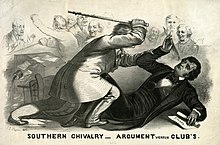
Back ضرب تشارلز سومنر Arabic Brooks-Sumner-Affäre German Charles Sumnerin kepitys Finnish Bastonatura di Charles Sumner Italian Rrahja e Charles Sumnerit Albanian
| Caning of Charles Sumner | |
|---|---|
 Political caricature of the caning, depicting Sumner on the floor holding a pen and his "Crime against Kansas" speech as Brooks lunges at him | |
| Location | Old Senate Chamber, United States Capitol, Washington, D.C. |
| Date | May 22, 1856 |
| Target | Charles Sumner |
Attack type | Assault by caning |
| Perpetrator | Preston Smith Brooks |
| Motive | Retaliation to an anti-slavery speech by Sumner |
| Verdict | Guilty |
| Convictions | Assault |
| Sentence | Brooks fined $300 ($10,170 in today's dollars) |
The caning of Charles Sumner, or the Brooks–Sumner Affair, occurred on May 22, 1856, in the United States Senate chamber, when Representative Preston Brooks, a pro-slavery Democrat from South Carolina, used a walking cane to attack Senator Charles Sumner, an abolitionist Republican from Massachusetts. The attack was in retaliation for an invective-laden speech given by Sumner two days earlier in which he fiercely criticized slaveholders, including pro-slavery South Carolina Senator Andrew Butler, a relative of Brooks. The beating nearly killed Sumner and contributed significantly to the country's polarization over the issue of slavery. It has been considered symbolic of the "breakdown of reasoned discourse"[1] and willingness to resort to violence that eventually led to the Civil War.
Although Sumner was unable to return to the Senate until December 1859,[2] the Massachusetts legislature refused to replace him, leaving his empty desk in the Senate as a public reminder of the attack.
- ^ "The Caning of Senator Charles Sumner". United States Senate. Retrieved February 15, 2013.
- ^ Creole (Dec 16, 1859) [Dec 9, 1859]. "Letters from Washington". Daily Delta. New Orleans, Louisiana – via Newspapers.com.